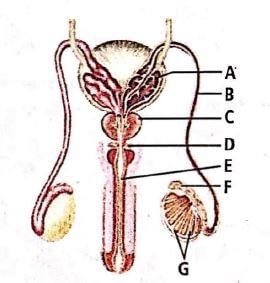Test: The Male Reproductive System (NCERT) - NEET MCQ
15 Questions MCQ Test Biology Class 12 - Test: The Male Reproductive System (NCERT)
If for some reason, the vasa efferentia in the human reproductive system get blocked, the gametes will not be transported from
The nutritive cells found in seminiferous tubules are
| 1 Crore+ students have signed up on EduRev. Have you? Download the App |
In most mammals, the testes are located in scrotal sac for
Read the following statements about the given diagram carefully and state which of them are correct?
(i) A carries urine and C stores sperms.
(ii) B secretes a fluid that helps in the lubrication of penis.
(iii) D produces testosterone but not sperms
(iv) C stores sperms

Where is the male reproductive system located?
Which one is correct for mammalian testis?
Match each function below with the associated part or parts of the human male reproductive system shown in the figure.
(i) Produces sperm
(ii) Conducts the sperm through the penis to the outside of the body
(iii) Produces seminal fluid
(iv) Connects the epididymis with the urethra

The given diagram refers toT.S. of testis showing sectional view of a few seminiferous tubules. Identify the parts labelled A-D and select the correct option.

Which of the following ducts are present outside the testis?
(i) Rete testis
(ii) Vasa efferentia
(iii) Vas deferens
(iv) Epididymis
|
87 videos|294 docs|185 tests
|



















